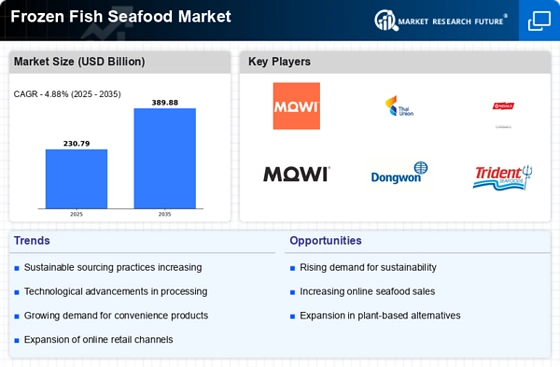Convenience and Ready-to-Cook Options
The Frozen Fish Seafood Market is significantly influenced by the growing demand for convenience and ready-to-cook meal options. As lifestyles become busier, consumers are increasingly looking for quick and easy meal solutions that do not compromise on quality. Frozen fish products, which often come pre-seasoned or pre-marinated, cater to this need by offering a hassle-free cooking experience. Market data indicates that the ready-to-cook segment is expanding rapidly, with a notable increase in sales of frozen seafood products. This trend is likely to continue, as more consumers prioritize convenience in their meal preparation, thereby driving growth in the Frozen Fish Seafood Market.
Rising Demand for Healthy Protein Sources
The Frozen Fish Seafood Market is experiencing a notable increase in demand for healthy protein sources. As consumers become more health-conscious, they are increasingly seeking alternatives to red meat, which has led to a surge in seafood consumption. According to recent data, seafood is recognized for its high protein content and beneficial omega-3 fatty acids, which are essential for heart health. This shift in dietary preferences is driving the growth of the Frozen Fish Seafood Market, as frozen fish provides a convenient and nutritious option for consumers. Furthermore, the market is projected to expand as more individuals incorporate seafood into their diets, potentially leading to a significant increase in sales and product offerings in the coming years.
Sustainability and Eco-Friendly Practices
Sustainability has emerged as a critical driver in the Frozen Fish Seafood Market. Consumers are becoming more aware of the environmental impact of their food choices, leading to a preference for sustainably sourced seafood. The industry is responding by adopting eco-friendly practices, such as responsible fishing methods and transparent supply chains. Data suggests that products labeled as sustainably sourced are witnessing higher sales, as consumers are willing to pay a premium for environmentally friendly options. This trend not only supports the health of marine ecosystems but also enhances the reputation of brands within the Frozen Fish Seafood Market, potentially attracting a more conscientious consumer base.
Technological Innovations in Freezing Techniques
Technological advancements in freezing techniques are playing a pivotal role in the Frozen Fish Seafood Market. Innovations such as flash freezing and improved cold chain logistics have enhanced the quality and shelf life of frozen seafood products. These advancements ensure that fish retains its freshness, flavor, and nutritional value, which is crucial for consumer satisfaction. Market analysis indicates that companies investing in state-of-the-art freezing technologies are likely to gain a competitive edge. As these technologies continue to evolve, they may further enhance the appeal of frozen seafood, thereby contributing to the growth of the Frozen Fish Seafood Market.
Expanding Distribution Channels and E-commerce Growth
The Frozen Fish Seafood Market is benefiting from the expansion of distribution channels and the growth of e-commerce platforms. As online shopping becomes increasingly popular, seafood retailers are leveraging digital platforms to reach a broader audience. This shift allows consumers to conveniently purchase frozen fish products from the comfort of their homes. Market data reveals a significant rise in online seafood sales, indicating a shift in consumer purchasing behavior. The ability to access a diverse range of frozen seafood products through e-commerce is likely to drive further growth in the Frozen Fish Seafood Market, as it caters to the evolving preferences of modern consumers.


















Leave a Comment